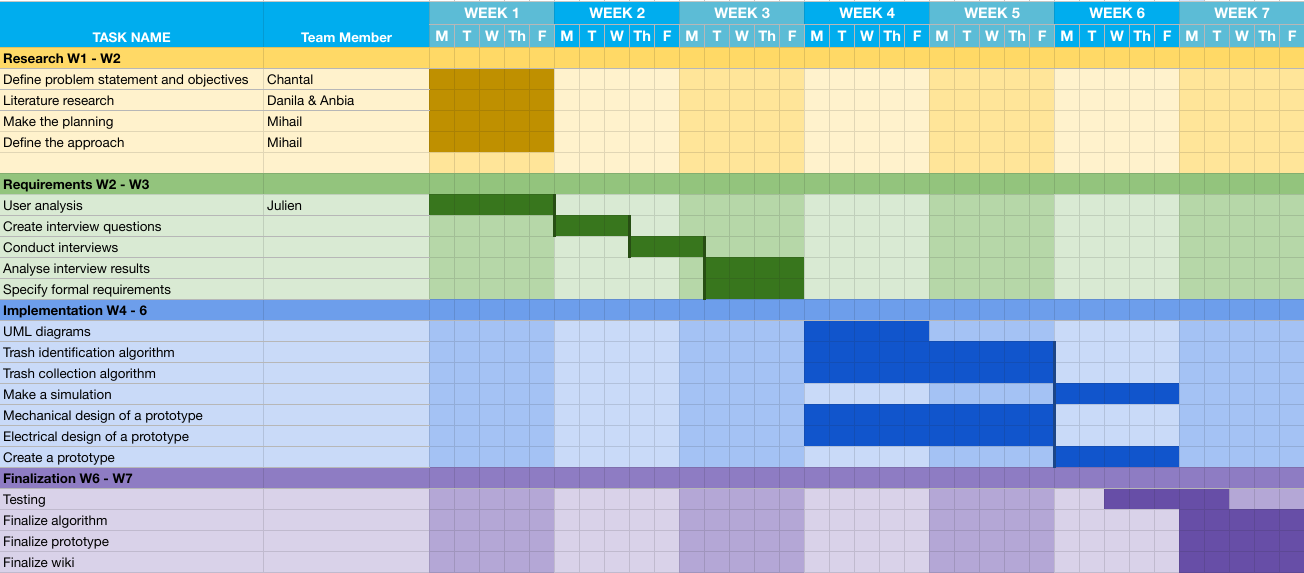PRE2024 3 Group14
WALL-E
Group members
| Name | Student ID | Current Study Programme |
|---|---|---|
| Chantal Smits | 1689339 | Electrical Engineering |
| Julien Rodriguez | 1829599 | Computer Science and Engineering |
| Mihail Abramov | 1813978 | Applied Mathematics & Computer Science and Engineering |
| Anbiya Popal | 1838849 | Electrical Engineering |
| Danila Bogdanovs | 1782746 | Electrical Engineering |
Introduction
The struggles of waste collection are a big issue nowadays. Waste is found in the streets, in the rivers and oceans, and plastics can even be found in some of our food now, due to a lack of recycling. Most people have struggled with wether some piece of litter goes into plastic, paper or waste bin, or alternatively, they are out somewhere and cannot find any bins at all. At festivals and other big events like it, a lot of waste is often left on the big fields. Clearing this trash is a task that needs to be done, but is very labour intensive. Therefore we think that this should, and could be automized. We want to create a set of robots, one flying above the field to locate the trash, and then a few for each different type of waste (platic, paper, glass, etc.). We think that these robots can be used for these fields most efficiently, since after the festivals, there is no need for them to interact with humans. People can be very unpredictable and we would rather focus on the functionallity of the robot and to make it as good as possible for this scenario. For this project we want to plan out the design of the robot, both it's hardware and software, but we do not think it is reasonable to create a prototype yet, both because there is not enough time or budget, and then we do not have to rush the design stages to make sure all of the parts get to us in time.
Approach
Phase 1 - research
Define the topic of the project and the approach taken. Perform literature research on the topic.
Phase 2 - requirements
Collect user requirements through interviews. Specify the requirements.
Phase 3 - implementation
Write the algorithm and make design of the robot. Build a prototype and perform simulations.
Phase 4 - finalization
Test the prototype and finalize both code and design. Give a presentation.
Planning
Based on the chosen approach the planning of the project was created. The four phases of the project were split into more specific tasks and the timing for each task is specified. The planning is summarized in the following Gantt chart below:

The research should be performed in the first two week. The requirements identification will be performed up to week 3. Having the results from research and requirements phases, the implementation phase will be performed. Implementation will span from week 4 to week 6. The finalization phase concludes the project in weeks 6 and 7 after the implementation is completed.
Milestones
End of...
Week 1 - having a plan for the project
Week 2 - finishing the research
Week 3 - finishing analysis and specifying user requirements
Week 5 - completing algorithm and design for the prototype
Week 6 - making a simulation and building a prototype
Week 7 - tested the prototype and presented the project
Literature Review
User and stakeholder analysis
The target users for our product would be:
- Event organizers who seek efficient and cost-effective cleaning solutions for outdoor events.
- Cleanup crews, who need support for manual trash collection. They could learn how to operate the robot, or work alongside it to improve efficiency.
Stakeholders:
- City waste management departments can be consulted on integration feasibility and potentially subsidize the product.
- Environmental agencies who focus on waste reduction can explore environmental benefits of the robot.
- General public, even though the robot is most efficient in an environment without humans, it must be able to detect their presence and act as safely as possible.
All of these users and stakeholders can be interviewed to provide important information on:
- Willingness to integrate automated solutions
- User perception
- Potential improvements of robot's design
- Safety concerns
- Potential cost savings
- Impact on environment
- Impact on cleaner's workload
- and so on...
Interviews
Requirements
Specification
Mechanical design
Electrical design
Trash identification algorithm
Trash collection algorithm
Simulation
Discussion and Further research
Conclusion
Planning
| Week | Student | Work Done | Total Time |
|---|---|---|---|
| 1 | Julien | Brainstorm meeting + planning (2h)/ Wrote User and stakeholder study (1h) | 3h |
| Mihail | |||
| Chantal | Introduction lecture (1h) brainstorm meeting + planning (2h) problem statement & objectives (1h) | 4h | |
| Danila | |||
| Anbiya | |||
| 2 | Julien | ||
| Mihail | |||
| Chantal | |||
| Danila | |||
| Anbiya | |||
| 3 | Julien | ||
| Mihail | |||
| Chantal | |||
| Danila | |||
| Anbiya | |||
| 4 | Julien | ||
| Mihail | |||
| Chantal | |||
| Danila | |||
| Anbiya | |||
| 5 | Julien | ||
| Mihail | |||
| Chantal | |||
| Danila | |||
| Anbiya | |||
| 6 | Julien | ||
| Mihail | |||
| Chantal | |||
| Danila | |||
| Anbiya | |||
| 7 | Julien | ||
| Mihail | |||
| Chantal | |||
| Danila | |||
| Anbiya |